Anti-Capitalism and Violence: Gord Hill Interviewed by Kersplebedeb
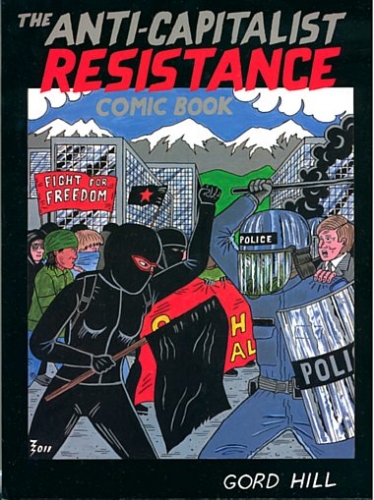
An interview conducted by Kersplebedeb in 2012 with Gord Hill, author the Anti-Capitalist Resistance, 500 Years of Resistance, and Antifa Comic Books, as well as the short history 500 Years of Indigenous Resistance. Gord Hill is a member of the Kwakwaka’wakw nation on the Northwest Coast. Writer, artist, and militant, he has been involved in Indigenous resistance, anti-colonial and anti-capitalist movements for many years, often using the pseudonym Zig Zag.
k: The opening graphic in The Anti-Capitalist Resistance Comic Book is striking, showing a Black Bloc member squaring off against a cop, each as representatives of the clash between Empire and free peoples from centuries past. To what degree do you feel that the clashes at today’s summits represent a continuity with the history of anti-colonial resistance?
gh: To start with, I wouldn’t limit the concept of anti-colonial resistance simply to counter summit mobilizations. But in general, I do think there’s a connection in that free, autonomous societies have always resisted the rule of civilization and its empires, which the graphic you refer to was meant to depict. Looking at just the summit protests, however, they are in some ways the equivalent to battles fought against empire by tribal peoples, including forms of self-organization, autonomy, even tactics. For example, tribal peoples in Western Europe fought in a somewhat chaotic autonomous manner, while Roman legions were in massed units, lines of heavily armoured troops, etc. You can see similar forms of struggle among social movements opposing state security forces today, the Black Bloc being somewhat similar to the “barbarian” tribes fighting Roman soldiers (who look very similar to modern day riot cops).
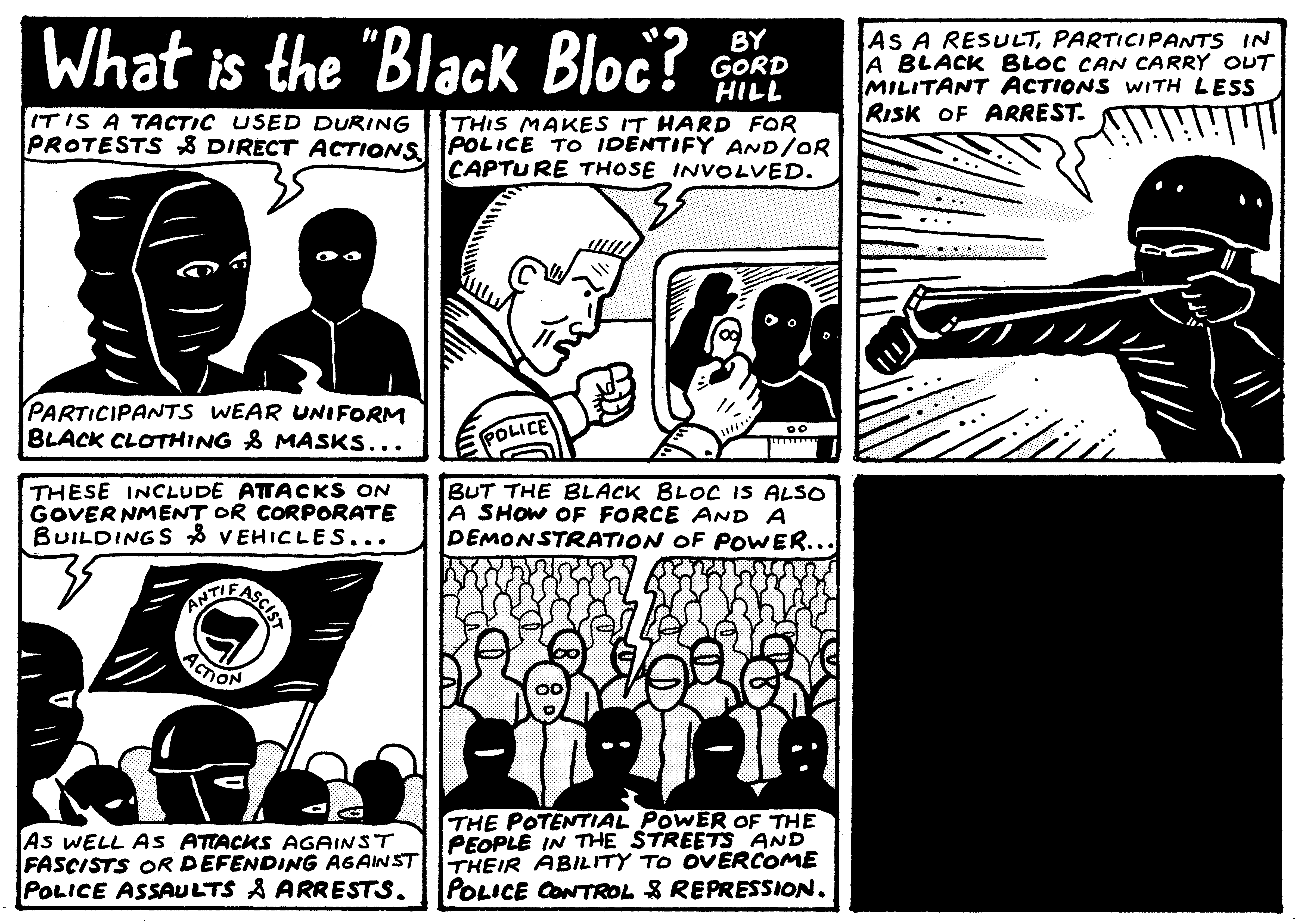
k: In the section of your comic book where you talk about the fall of the Roman Empire, you show how assimilated tribal chiefs took advantage of the power vacuum to establish their own kingdoms. Some comrades argue that we’re now in a period of the decline of imperialism, but is there anything we can do to prevent history from repeating itself, and today’s “assimilated tribal chiefs” in the neo-colonies from similarly filling the power vacuum as warlords to set up their own fiefdoms?
gh: The “assimilated tribal chiefs” are already circulating and jockeying for position within our social movements, if we consider the collaborative role of union bureaucrats, political party members, pacifist ideologues, etc. Internally, we make efforts to keep our autonomy and decentralized manner of organizing while defeating those that would control and contain us. In the event of a systemic collapse, what would prevent warlords as such from rising? Organized resistance capable of defeating such forces, the seeds of which must be planted now so that when the crisis matures so does the resistance. it should also be noted that even among the European tribes collaborator chiefs were targeted with death and there was significant internal struggles among tribes in responding to both the advance of the Roman empire and its collapse.
k: The Anti-Capitalist Resistance Comic Book focuses almost exclusively on clashes at protests that have occurred in the media spotlight. Do you consider these protests, which some people have criticized as “summit hopping”, to be particularly strategic? Is there a particular importance in telling these stories?
gh: The summits depicted in the comic are historical events that involved tens of thousands of people directly in the streets, and which affected many more (via corporate and alternative media, etc.). They inspired many and showed the power of the people when mobilized, despite the vast deployment of state security forces. This is a strategic gain that is absolutely necessary for resistance movements. In regards to telling these stories, it is up to us to maintain our history of resistance, no one else will do it for us. It is in fact in the interests of the ruling class that such histories be erased because they are such “bad examples.” I personally don’t like the term “summit hopping” as it belittles the efforts of organizers attempting to mobilize against such events in their areas. It also arises from the false belief that we either organize “locally” or “summit hop,” a division that doesn’t exist in reality.
k: I think what you’re saying there is really borne out by what we’re seeing at the moment in Quebec, where some of the same people who were involved in the militant actions at the G20 or even at Montebello before that, have been participating in the present mobilization.
gh: Ya, I’ve heard the same thing about the #Spanish Revolution, which Occupy Wall Street was modeled after. Many of the organizers were ‘veterans’ of the so-called anti-globalization movement.
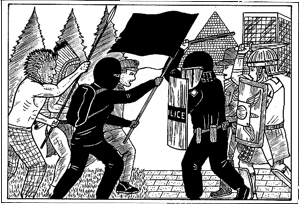
k: In your comic book, you show the Mohawk uprising and the Zapatistas in 1990, but then skip ahead to APEC in 1997 and then J18 in 1999. In many cities, the 90s were a decade where militant antifascist politics became an important area of action. Do you see any connection between the antifa activism of the 90s and then much broader antiglobalization movement that followed?
gh: Yes, certainly, in that many of the Anti-fa militants were key organizers in some of these mobilizations and also promoted militant tactics such as Black Blocs over those years. But I had limits on how much of the story could be told, and the anti-APEC and Zapatista rebellion more directly influenced the so-called anti-globalization movement with the focus on neo-liberalism, which I think really made people aware of the global restructuring then underway.
k: In Toronto there was Anti-Racist Action, and in Montreal we had the somewhat pathetic example of the “World Anti-Fascist League” and then (much better) RASH and SHARP; what kinds of groups were active on the West coast at the time?
gh: In Vancouver there was less of a fascist threat during this period. There were smaller numbers of neo-nazis organized around Aryan Nations, and there was an Aryan Resistance Movement, as well as Tony McAleer’s “Canadian Liberty Net,” mostly a telephone line that had racist messages and info. As a result there wasn’t an active ARA chapter. We did set up a group called Anti-Fascist Info, which was mostly an informational group that organized film screenings, forums, etc. There were numerous autonomous anti-fascists who would show up at anti-racist rallies, for example in 1993 I think the Canadian Liberty Net attempted to organize a forum with Tom Metzger from the White Aryan REsistance (WAR). This meeting was shut down after militants learned of the meeting place. There was also a liberal reformist group called the BC Organization to Fight Racism (BCOFR) which had formed in the early 1980s when the KKK was more active here.
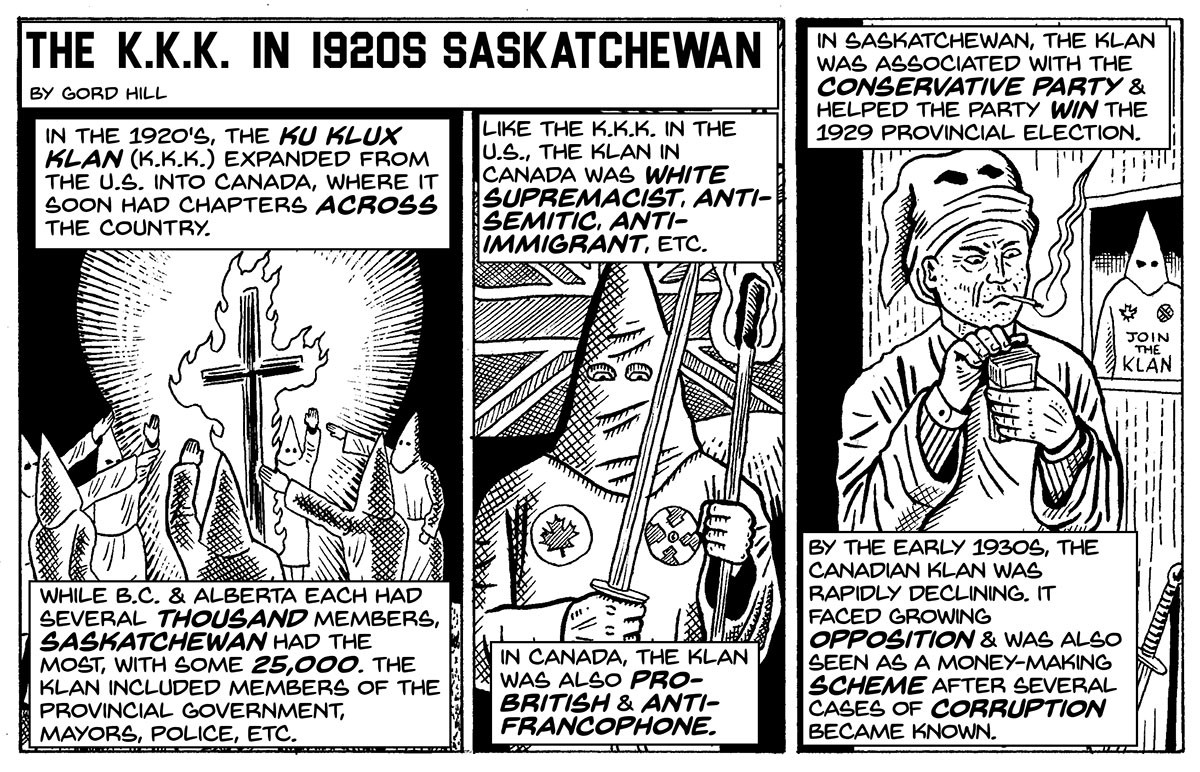
k: Your work over the years, both as an activist and a movement artist-intellectual, has focussed on Indigenous resistance struggles, which have been going on uninterrupted for over five hundred years. Yet you also obviously have an affinity for some of the traditions of resistance that emerged much more recently in Europe, especially the German Autonomen. There seem to be glaring differences between the circumstances that have given rise to these resistance struggles – to what degree do you see them as being compatible, or perhaps more to the point, what how do you see them as being relevant to one another?
gh: Yes, my main focus is anti-colonial and anti-capitalist resistance. As capitalism arose from Europe’s colonization of the Americas, I see the two as intertwined. The imposition of capitalist relations among Indigenous peoples has resulted in class hierarchies, today manifested in the Aboriginal business elite and their collaborator political organizations. I think decolonization must include an anti-capitalist analysis or it risks simply being another form of assimilation (neo-colonialism). And since we have to develop anti-capitalist resistance it makes sense to study and understand such movements both historically and current. The Autonomen, as an autonomous and decentralized political force/social movement, share some qualities with Indigenous tribal society and also serve as a model for radical anti-capitalist resistance in a modern industrialized nation-state.
k: In the 1970s, at the time when the Autonomen were first developing in West Germany, and during the second wave of Autonomia in Italy, there was the related phenomenon of the “Urban Indians” – was this just a racist rip-off, or do you see there as something positive in this kind of identification, especially as the people who identifies this way may have been anti-imperialist, but really had no connection or contact with the anti-colonial Indigenous struggles here?
gh: The “Urban Indians” were probably sincere in their efforts to “decolonize” from Western Civilization, but ya it is a kind of racist appropriation of culture which would not go over very well here in North America. The ironic thing is they could have reached back to the tribal history of Europe itself–the Vandals, the Goths, Celts, etc. all resisted their colonization by the Romans and had numerous military victories, including the sacking of Rome itself on a few occasions, which seems like a great historical legacy of their own ancestors engaging in anti-colonial resistance.
k: At the Montreal Anarchist Bookfair, one of the best moments for me is when a guy came over to my table and was excited because he recognized himself in your comic – he had been arrested at the G20 and his story had made it into your pages. Other people i know also get a grin when they see someone who might be them. Leaving aside the question of how autobiographical your book may be, what is the significance of using art to keep alive the stories and anecdotes from these events?
gh: Tribal peoples have always used to art to maintain their histories and culture, as have social movements. In regards to the historical events depicted in the comic, I hadn’t seen too much artwork attempting to maintain this history, for example with comics, which I find to be a great form of communication.
k: I imagine your art will continue to serve this function for the movement in the years to come. Do you have any future projects along similar lines that you’d like to tell us about?
gh: Not at the moment, perhaps you have some ideas?
k: Ha! Well, you could always come to Montreal, lots of interesting things happening here these days…
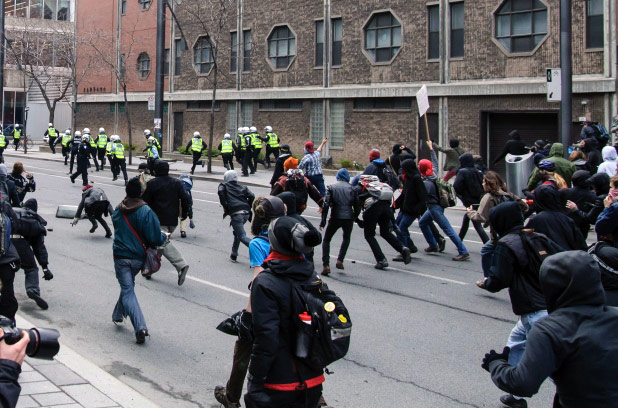
k: Violence is central to your stories, and the idea seems to be that the more of it, the better. Why is violence so important, and what do you have against peaceful protest?
gh: I would say violence is central to the stories I depict because they are a critical moment in the social conflict out of which they arise. It isn’t every day that the state mobilizes thousands of cops and soldiers, or when thousands of militants converge on a specific battlefield as it were. In regards to levels of violence I think this is a tactical question that is very much dependent on conditions and context. In Seattle 1999 there was a fairly low level of violence engaged in by protesters, certainly in the downtown core where it was much more of a classic “police riot.” In the Capitol Hill area there was more sustained street fighting, but of course the most spectacular impact arose from the small Black Bloc action in the downtown which saw a fairly low level of violence (there were no confrontations with riot police with a good amount of property destruction carried out). I have nothing against “peaceful protest” and have participated in many more such protests than “violent” ones. It’s a question of tactics and strategy. I would say, however, that I am opposed to pacifist ideologues attempting to impose their beliefs on others while undermining militants.
k: Various writers have argued that violence against the oppressor can actually be psychologically liberating for people, a way of dealing with and healing from the violence of everyday day life under patriarchal colonial capitalism…
gh: Ya that was the message of Franz Fanon. I would say it can be psychologically liberating, and an important part of that is showing that the oppressor is not omnipotent, that they can be fought and even defeated. Without this people feel powerless, which contributes to apathy. People need a fighting spirit and the will to resist, and I don’t think pacifism is very inspiring to a lot of people.
k: In the context of the antiglobalization movement, which you literally illustrate in your comic book, there were debates about nationalism, about cooperating with the right (i.e. Pat Buchanan, Ralph Nader, etc.), about conspiracy theories – but the only debate that appears in your comic book is the debate over violence. Did you purposefully decide to highlight this one question?
gh: Yes, I think it’s a much more critical debate than those over larger strategic ones at this time, such as nationalism or conspiracy theories. I think within more radical social movements there is already an understanding around nationalism and the right-wing, a consensus of sorts that generally rejects these concepts. But within this there is a division over the question of violence and militant actions that must be resolved to some degree before greater unity of effort can be achieved. As for conspiracy theories, they certainly had an impact on the Toronto G20 due to the involvement of some conspiracists promoting the idea that the Black Bloc was a police operation, and maybe some debate on this should’ve been included, but by the end of the G20 comic I was seriously pressed for space…
k: This spring in Quebec there has been a student strike which has developed with strong anticapitalist politics and a rapid escalation on the streets. A lot of the protest tactics which were pioneered by small, even tiny, groups over the past fifteen years are now in the headlines every day, and being taken up by much larger numbers of people. How much potential do you see for this kind of urban militant resistance to spread in North America? Do you see any potential pitfalls?
gh: I think it can spread very far and wide in a very short period of time. I began to realize the potential for this after reading a report from Greece on the 2008/09 rebellion there, where a similar phenomenon of thousands of youths adopted the tactics and methods that had been used by smaller numbers of anarchists for years. This wasn’t simply natural intuition–these kids and many others in Greek society have watched the anarchists in action for over two decades now. It’s like “monkey see, monkey do” and that’s the importance of showing examples of militant resistance and serving as a model of how it can be carried out. The Canucks Riot of 2011 here in Vancouver was similar–during the 1994 hockey riot there were no cars arsoned. In 2011, over 16 or 17 cars were torched, including 4 police cars. I’m sure many of these youth rioting had seen some coverage of the Toronto G20 and the four burning cop cars that resulted. The Occupy movement, whatever its shortcomings, shows that a large segment of the population believes that some form of social change is necessary. They weren’t willing to join the Occupiers, but they’re sitting there and observing all this social mobilization and conflict going on in the world. It might only take one incident or issue to instigate social revolt, and as conditions continue to deteriorate this potential grows. The potential pitfalls are greater repression of social movements and an increase in police controls over the population, but that’s part of the process of resistance.
k: If or when things do fall apart, isn’t there a risk that the racism, patriarchy, and capitalist values that people have internalized might lead significant sections of the oppressor nations, especially its middle classes, to veer to the far right?
gh: I’d say it’s a very real possibility and one that we can see occurring even now, with the right-wing Christian patriot militia movement in the US. This movement expanded during the 1990s but then declined after 9/11 when the so-called “War on Terror” began. In 2008 however, when Obama was elected amidst an economic crisis, the patriot militia movement expanded rapidly with part of it mainstreaming as survivalism (itself a sign of the times). As of yet this right-wing has not coalesced into a unified movement, although all the ingredients are there for fascist style paramilitary organizing on a large scale. But the thing about the declining economic conditions is that significant segments of the middle-class may become working class, as occurred in Argentina during the 2001-02 economic crisis there.
k: Still thinking of Quebec, after a few weeks of demonstrations in which police were repeatedly sent running, both the federal government and the city of Montreal began drafting legislation and changing bylaws to criminalize wearing masks and increase penalties for even being present during a militant demonstration. With potential consequences of up to ten years in prison and thousands of dollars in fines, the movement is now going to face significantly heavier repression in the courtrooms, and perhaps in the prisons too. On top of that, the provincial government has passed Law 78 which criminlizes a broad range of protest activities, and is clearly meant to break the back of the movement. What will be necessary for radicals to break through this escalation on the part of the State, and what effect will this have on our struggles?
gh: People join resistance movements for a variety of reasons–some ideological, some for friendship, some for financial reasons or personal security. But an important factor is the potential for victory–only those committed ideologically will join a group doomed to failure or defeat. If movements surrender or abandon a struggle after the first act of repression many will see it as weak and impotent. If a movement overcomes this repression and continues to advance, it will more likely gain new members and inspire others. But it also depends on the context–what is the struggle and how much emotion is invested in it by the participants? Is it a matter of life or death, is it a significant part of the core beliefs of the participants, an important matter of principle? In regards to the Quebec student strike, it seems that many participate or sympathize because it is a matter of principle (the right to education, or the right to assembly and protest). They seem to be able to mobilize the numbers necessary to defy the ban on protests and masks for the moment, but the real question will be how social movements without such a large base will fair. To answer the question more directly, I would speculate that mass disobedience of the new law would be crucial to show that the movement cannot be intimidated and controlled so easily. The disruptions resulting from the protests can create political pressure to repeal the legislation, just as they did to create it. But the movement might have to raise the level of struggle to one that it cannot maintain, given that its base, even though large by our standards, is ultimately limited. The law itself will undoubtedly contribute to the radicalization of even more people, just as the student strike itself has.
k: What do you think of the North American left today?
gh: It has great potential considering the worsening socio-economic conditions, the convergence of ecological and economic crises, etc. In general, at the moment it seems weak and fixated on intellectual efforts rather than physical activities, dominated by middle-class social democrats and their suffocating pacifist doctrine, and likely to turn tail and run at the first sign of aggression by our class enemy. The only hope lies in the radicalizing influence of militants, which is why the state sees the bogey-man Black Bloc as the greatest threat, and not those sectors of the left which can be easily co-opted. Furthermore, I think many people don’t join “leftist” struggles because they see little potential for victory, and little that actually inspires them.
The N. American left today largely inspires middle-class liberals and reformists, and the last thing they want is radical social change. The left or social movements in general will become far more effective when working class people actually join and participate in significant numbers, which I think will happen as the economic conditions decline further. I believe this is one of the reasons we must promote a diversity of tactics within out movements, because many working class people intuitively understand that radical social change requires some level of conflict, as opposed to middle-class reformists who seek to avoid both.
k: Violence aside, can you think of any other strategies or tactics that people are using presently that might challenge middle-class control of the left?
gh: I’m not sure, but I think some examples may be found in Occupy Oakland, where more people of colour and working class people were involved and radicalized what was a predominantly white middle-class movement. Another example might be the Wet’suwet’en in central ‘BC’ who are resisting the Enbridge pipeline as well as the Pacific Trails Pipeline, a couple of years ago they severed their connection to mainstream environmental NGO’s and began working with grassroots resistance groups. But overall I think middle-class control will be undermined as social conditions continue to decline and more working class elements become mobilized in the resistance.
k: In the time that you have been involved in resistance movements, we have experienced numerous battles on multiple fronts, with both surges forward as well as defeats. What do you think we need to prepare ourselves for over the next ten years?
gh: Preparation must be based on our analysis of what may occur over the next ten years. Worsening economic conditions, ecological crisis, increased state repression… and potential systemic collapse in localized areas. Typically under such conditions there arises the need for greater solidarity and mutual aid to be practised, greater efforts at self-sufficiency (including food production, shelter, etc.), physical self-defense, survival skills, and better education on security culture. Given the growing cynicism with the current system, anti-capitalist resistance should find fertile ground for mobilizing. Anti-fascist or anti-racist efforts may become more important in some areas as well, as the state and ruling class typically resort to fostering fascist movements and racist sentiment among the population in times of crisis.

The Anti-Capitalist Resistance Comic Book
Paperback
96 pages
Published by Arsenal Pulp Press in 2012
ISBN 9781551524443
Leave a Reply